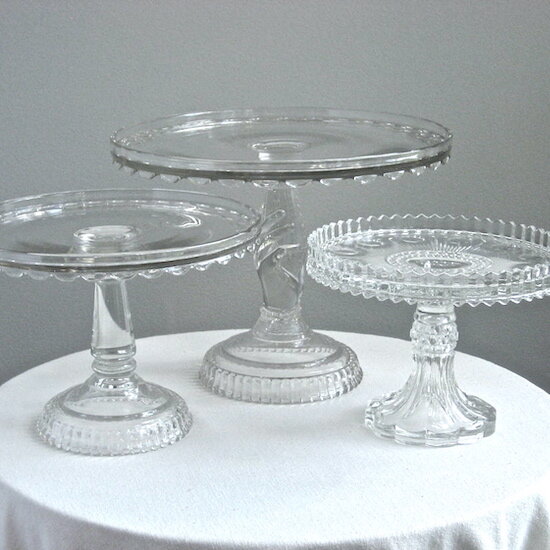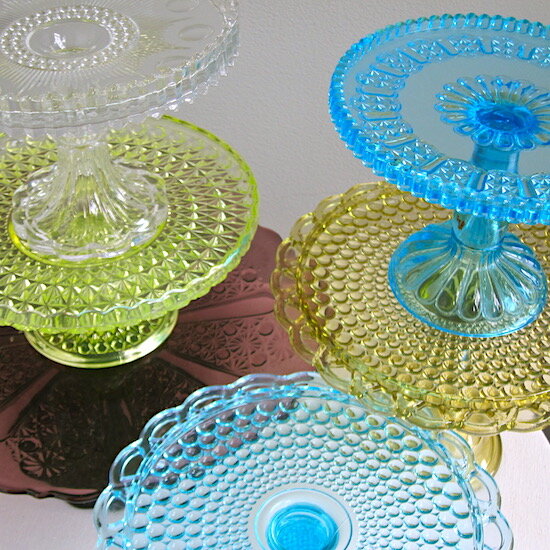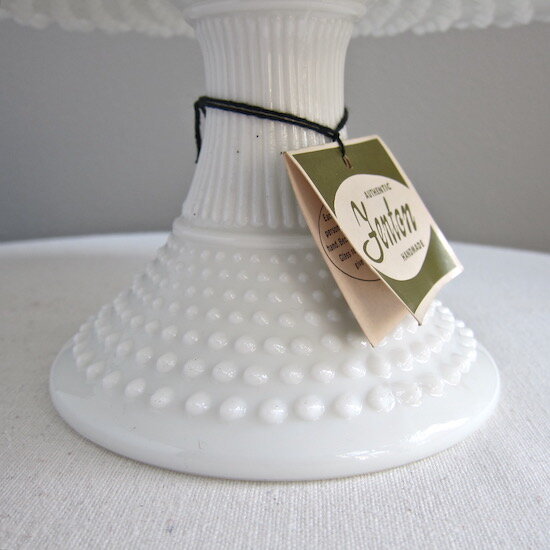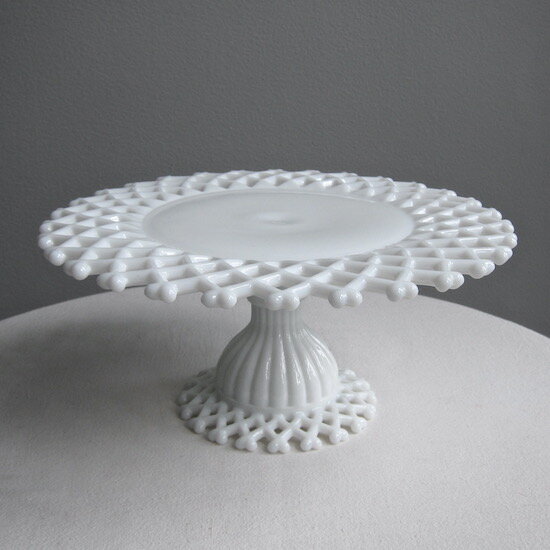I’ve found some lovely vintage and antique glass cake stands lately, dating from the 19th century into the 1960s. I sell lots of cake stands in my Etsy shop, primarily to brides who want to use them at their receptions. I’ve had brides buy a group of four or five different cake stands to display cupcakes and one bride bought ten of the same model to use first at pre-wedding events, then she gave them to members of the bridal party. Milk glass from the 1960s is quite popular these days, and 19th century cake stands, which come in literally thousands of patterns, have long had a following.
Turquoise blue milk glass cake stands--in two graduated sizes--topped by a tumbler.
Left and center: Cake stands by Hobbs, Brokunier, Co., circa 1879; right: 'Manhattan' pattern by US Glass, circa 1902.
Detail of Manhattan cake plate.
Detail of the Hobbs Brokunier 'Tree of Life' cake stand
EAPG, as it is often called, is short for early American pattern glass--though ‘early’ is a bit of a misnomer, as this type of glass dates from the mid-19th century to about 1910. Pressing patterns into the glass was an affordable way to create highly elaborate decoration, which made these pieces accessible to a broad audience. Most patterns were made in colorless glass, but some blues, yellows, greens and other colors were used as well.
Amethyst cake stand, possibly Fenton, circa 1930
Vaseline glass cake stand, circa 1880
Pattern glass (and 19th-century glass in general) is prone to small specks of sand or ash within the glass (called inclusions), bubbles and sometimes the plate is slightly off level. Evidence of utensil marks on the top of the plate is also pretty standard. Condition is always important, but because of the age of the older cake stands, I tend to be a little bit more forgiving of tiny chips in the glass
Two 'Thousand Eye' cake stands by Adams, 1870s
A great online resource for information on 19th-century glass is www.patternglass.com--so many pretty examples are shown!
The popularity of milk glass in the 1950s and ‘60s was at least in part a revival of the earlier pattern glass, with some companies even using the old molds of popular patterns. Fenton and Westmoreland were the leading manufacturers of milk glass, both creating an opaque, snowy white glass. Though each cake stand was made in a mold there was a certain amount of hand finishing, which leads to minor variations.
This is the most popular cake stand I sell--Fenton's hobnail pattern milk glass cake stand, produced from the 1950s into the 1980s.
The earlier version of Fenton’s hobnail cake stand has a ribbed support. The glass is unmarked, but it originally had a paper label. After the early 1970s, there is a molded Fenton mark within an oval on the underside of the foot.
Westmoreland ‘Doric’ cake stands.
Fenton Silver Crest cake stand.
Fenton ‘Silver Crest’ cake stand.
A more simple, modern take was Fenton's 'Silver Crest' line which included a band of colorless glass at the rim. Eventually, Fenton used many different shades of glass in many combinations, such as 'Gold Crest', ‘Emerald Crest’ and others.
Detail of a Fenton ‘Gold Crest’ cake stand.
As the name suggests, white was the usual color for milk glass, but most manufacturers produced opaque glass in limited range of colors as well. Fenton’s line of pastel colors was made only for a short time in the mid 1950s and is very desirable today--especially the turquoise.
Blue milk glass was made in the 19th and early 20th centuries as well--the top cake stand is likely French, circa 1950, the middle is Fenton's green pastel 'Spanish Lace' from 1954, and the bottom is Fenton's turquoise Silver Crest from the 1950s.
Fenton ‘Rose Crest’ cake stand, mid 1950s.
Something important to note--many brides have asked me if I have a vintage pedestal cake stand in a size large enough to accommodate an 18 inch round (or larger) wedding cake. Unfortunately, I don’t know of any vintage cake stands larger than 13 or maybe 14 inches in diameter, and those generally have space for only a 10 or 11 inch round cake. Even new glass or ceramic pedestal cake stands can be difficult to find in large sizes because of the limitations of the material (both tend to warp).
'Colony' by Indiana Glass, 1960s.
There are many more patterns and colors that I have not illustrated--these are just a few of the vintage cake stands in my shop or that I have sold in the past. You can stop by my Etsy shop here--I am happy to work with brides to find just the right piece!
I’m also looking to buy individual examples of unusual cake stands or entire collections. You can be in touch with me here.
An unusual Fenton example--no hobnails, no silver crest. Just plain!
A group of blue Westmoreland glass in the ‘Ring and Petal’ pattern.
Cake stand made by Fostoria in the Arlington pattern.
Fenton 'Thumbprint' cake stand.
Lattice border cake stand by Westmoreland.
Pink milk glass cake stand by Jeannette.
'Teardrop' pattern by Fenton, made between 1958 and 1966.
Fenton 'Cactus' pattern cake stand from the 1950s.
© All text and images are copyright of Jeni Sandberg 2011-2020.































































